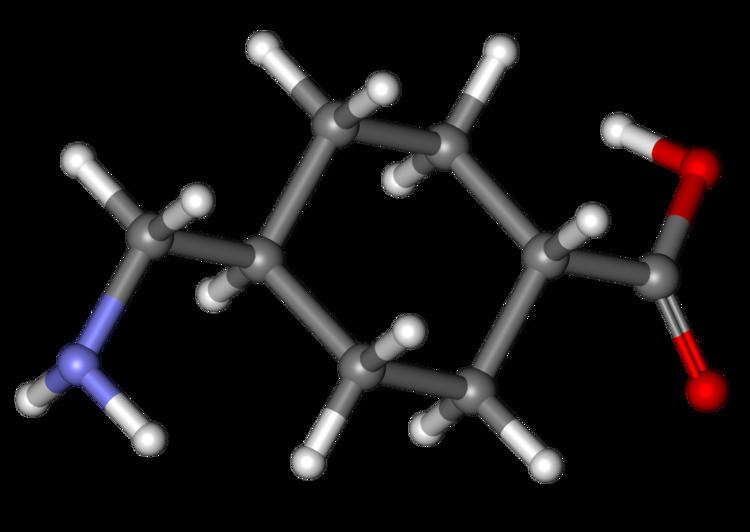Trade names Cyklokapron, others Routes ofadministration by mouth, injection Formula C8H15NO2 Molar mass 157.21 g/mol ATC code B02AA02 (WHO) DrugBank DB00302 | Pregnancycategory B Bioavailability 34% CAS ID 1197-18-8 Biological half-life 3.1 h Pronunciation ˌtran-eks-ˌam-ik- | |
 | ||
AHFS/Drugs.com FDA Professional Drug Information Legal status UK: P (Pharmacy medicines) | ||
Tranexamic acid in the emergency department
Tranexamic acid (TXA) is a medication used to treat or prevent excessive blood loss from major trauma, surgery, tooth removal, nose bleeds, and heavy menstruation. It is also used for hereditary angioedema. It is taken either by mouth or injection into a vein.
Contents
- Tranexamic acid in the emergency department
- Tranexamic acid for the treatment of heavy menstrual bleeding
- Medical uses
- Trauma
- Heavy menstrual bleeding
- Surgery
- Dentistry
- Other uses
- Adverse effects
- Special populations
- Mechanism of action
- Society and culture
- Brand names
- Approval
- References
Side effects are rare. Some include changes in color vision, blood clots and allergic reactions. Greater caution is recommended in people with kidney disease. Tranexamic appears to be safe for use during pregnancy and breastfeeding. Tranexamic acid is in the antifibrinolytic family of medications.
Tranexamic acid was discovered in 1962 by Utako Okamoto. It is on the World Health Organization's List of Essential Medicines, the most effective and safe medicines needed in a health system. Tranexamic acid is available as a generic medication. The wholesale cost in the developing world is about 4.38 to 4.89 USD for a course of treatment. In the United States a course of treatment costs 100 to 200 USD.
Tranexamic acid for the treatment of heavy menstrual bleeding
Medical uses
Tranexamic acid is frequently used following major trauma. Tranexamic acid is used to prevent and treat blood loss in a variety of situations, such as dental procedures for hemophiliacs, heavy menstrual bleeding, and surgeries with high risk of blood loss.
Trauma
Tranexamic acid has been found to decrease the risk of death in people who have significant bleeding due to trauma. Its main benefit is if taken within the first three hours.
Heavy menstrual bleeding
Tranexamic acid is used to treat heavy menstrual bleeding. When taken by mouth it both safely and effectively treats regularly occurring heavy menstrual bleeding. Another study demonstrated that the dose does not need to be adjusted in females who are between ages 12 and 16.
Surgery
Dentistry
In the United States, tranexamic acid is FDA approved for short-term use in people with severe bleeding disorders who are about to have dental surgery. Tranexamic acid is used for a short period of time before and after the surgery to prevent major blood loss and decrease the need for blood transfusions. In people with hemophilia, combinations of tranexamic acid and factor VII or IX have effectively decreased blood loss and the need for transfusions after dental surgery In one person with mild hemophilia, a combination of tranexamic acid and desmopressin effectively stopped bleeding
Tranexamic acid is used in dentistry in the form of a 5% mouth rinse after extractions or surgery in patients with prolonged bleeding time, e.g. from acquired or inherited disorders.
Other uses
Adverse effects
Common side effects include:
Rare side effects include:
These rare side effects were reported in post marketing experience and frequencies cannot be determined.
Special populations
Mechanism of action
Tranexamic acid is a synthetic analog of the amino acid lysine. It serves as an antifibrinolytic by reversibly binding four to five lysine receptor sites on plasminogen or plasmin. This prevents plasmin from binding to and degrading fibrin and preserves the framework of fibrin's matrix structure. Tranexamic acid has roughly eight times the antifibrinolytic activity of an older analogue, ε-aminocaproic acid.
Society and culture
TXA was discovered in 1962 by Utako Okamoto. It has been included in the WHO list of essential medicines. TXA is inexpensive and treatment would be considered highly cost effective in high, middle and low income countries.
Brand names
Tranexamic acid is marketed in the U.S. and Australia in tablet form as Lysteda and in Australia and Jordan it is marketed in an IV form and tablet form as Cyklokapron, in the UK as Cyclo-F and Femstrual, in Asia as Transcam, in Bangladesh as Traxyl, in India as Pause, in South America as Espercil, in Japan as Nicolda, in France and Romania as Exacyl and in Egypt as Kapron. In the Philippines, its capsule form is marketed as Hemostan and In Israel as Hexakapron.
Approval
The U.S. Food and Drug Administration (FDA) approved tranexamic acid oral tablets (brand name Lysteda) for treatment of heavy menstrual bleeding on 13 November 2009.
In March 2011 the status of tranexamic acid for treatment of heavy menstrual bleeding was changed in the UK, from PoM (Prescription only Medicines) to P (Pharmacy Medicines) and became available over the counter in UK pharmacies under the brand names of Cyklo-F and Femstrual, initially exclusively for Boots pharmacy, which has sparked some discussion about availability. (In parts of Europe - like Sweden - it had then been available OTC for over a decade.) Regular liver function tests are recommended when using tranexamic acid over a long period of time.
